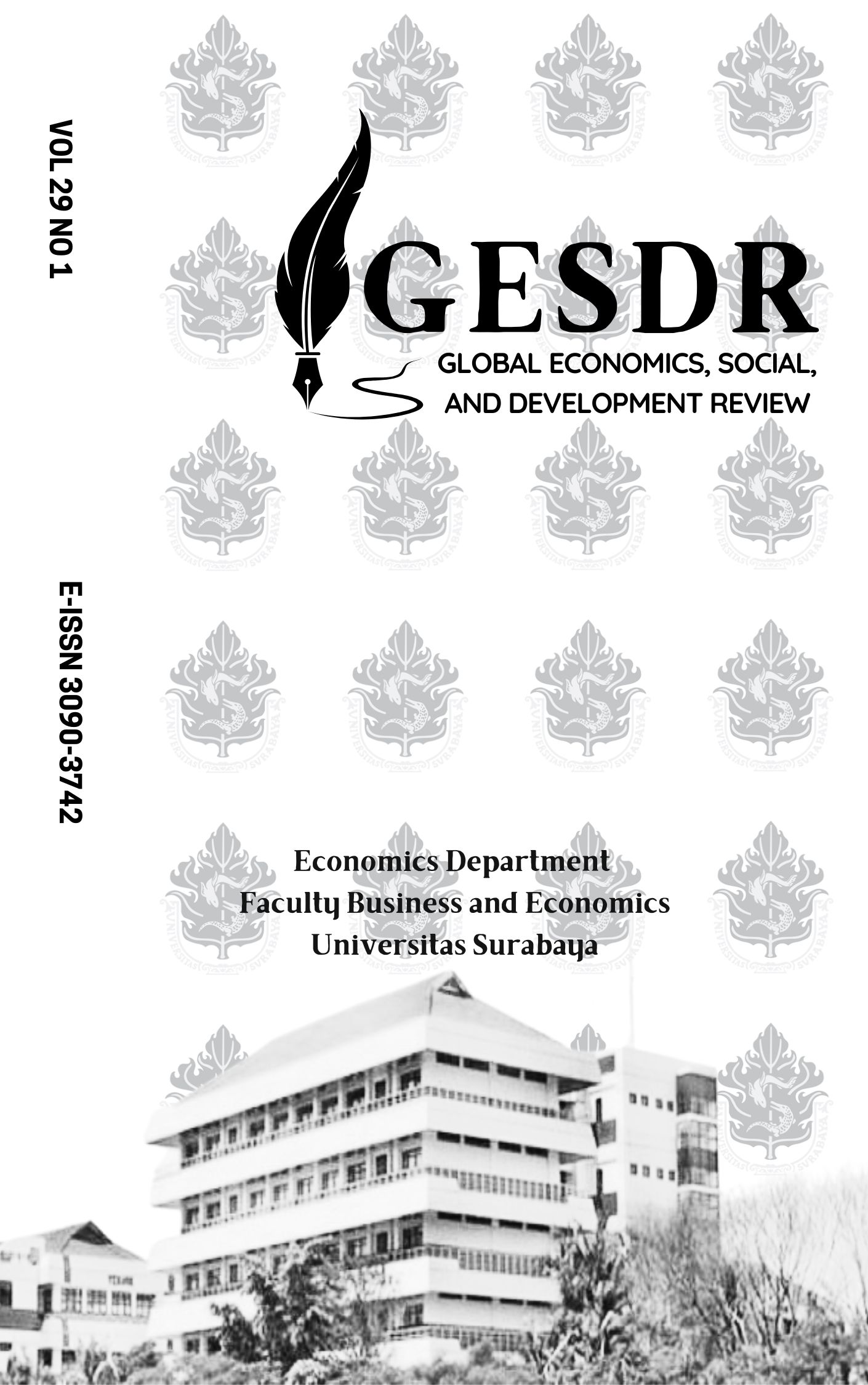The Impact of Food Energy Consumption and Poverty Levels on the Prevalence of Food Inadequacy in Indonesia
 Abstract Views:
149 times
Abstract Views:
149 times
 PDF Downloads:
65 times
PDF Downloads:
65 times
Abstract
Food security in Indonesia continues to face serious challenges despite the declining poverty rate, indicating that income growth alone does not necessarily translate into improved nutritional outcomes. This study examines the effects of household food energy consumption and poverty levels on the prevalence of inadequate food consumption across 34 provinces in Indonesia from 2019 - 2024. The findings reveal that higher household food energy consumption significantly reduces the prevalence of inadequate food consumption, whereas poverty levels do not exhibit a significant effect. These results diverge from much of the existing literature that positions poverty as the primary determinant of food insecurity. The novelty of this study lies in demonstrating that food energy adequacy exerts a more direct and consistent influence than poverty status in explaining food insecurity at the provincial level. The policy implication is that poverty alleviation alone is insufficient to address nutritional deficiencies. Instead, interventions should focus on improving household access to energy-dense and nutritious foods through local agricultural development, food price stabilization, and targeted nutrition programs. Such strategies are considered more effective in supporting the achievement of the Zero Hunger target in Indonesia.
Downloads
References
Agustina, R., Mufida, R., Lasepa, W., Mustika, A., Debilauralita, A., Limbong, S. T., Siregar, D. A., Prafiantini, E., Manikam, N. R., & Soewondo, P. (2025). Nutrient Intake Adequacy among Adults in Indonesia and Malaysia: A Systematic Review and Meta-Analysis. Current Developments in Nutrition, 9(5). https://doi.org/10.1016/j.cdnut.2025.106010
Alfin, L. C. (2025). Determinants of Poverty in East Java : Education, Unemployment , and Minimum Wage. Global Economic, Social, and Development Review (GESDR) 29(1), 1–11. https://doi.org/10.24123/gesdr.v29i1.7047
Awad, A. (2023). The Determinants of Food Insecurity among Developing Countries: Are There any Differences? Scientific African, 19. https://doi.org/10.1016/j.sciaf.2022.e01512
Baltagi, B. H. (2021). Econometric Analysis of Panel Data. (6th ed.). Springer Nature. https://doi.org/10.1007/978-3-030-53953-5
Botreau, H., & Cohen, M. J. (2020). Gender Inequality and Food Insecurity: A Dozen Years after The Food Price Crisis, Rural Women still bear The Brunt of Poverty and Hunger. Advances in Food Security and Sustainability, 5, 53–117. https://doi.org/10.1016/bs.af2s.2020.09.001
Badan Pusat Statistik Indonesia. (2023). Statistik Nilai Tukar Petani 2023. Retreived 20 Agustus 2025. https://www.bps.go.id/id/publication/2024/04/23/d49e2636396e0b8311a2b53b/statistik-nilai-tukar-petani-2023.html
Braun, J., & Torero, M. (2021). The Global Cost of Reaching A World Without Hunger: Investment Costs and Policy Action Opportunities. Food Policy, 104(January), 102151. https://doi.org/10.1016/j.foodpol.2021.102151
Dangles, O., & Struelens, Q. (2023). Is Food System Research Guided by The 2030 Agenda for Sustainable Development? Current Opinion in Environmental Sustainability, 64, 101331. https://doi.org/10.1016/j.cosust.2023.101331
Machfud, E. F. K., & Martianto, D. (2023). Optimalisasi Konsumsi Pangan pada Rumah Tangga Berpendapatan Rendah di DKI Jakarta. Jurnal Ilmu Gizi Dan Dietetik, 2(1), 37–44. https://doi.org/10.25182/jigd.2023.2.1.37-44
Fatmah, F. (2024). Factors Associated with Food Security in Depok City, Indonesia during The COVID-19 Pandemic: A Cross-Sectional Study. Frontiers in Sustainable Food Systems, 8(April), 1–10. https://doi.org/10.3389/fsufs.2024.1327887
Galanakis, C. M., Daskalakis, M. Ι., Galanakis, I., Gallo, A., Amaranta, E., Marino, E., Chalkidou, A., & Agrafioti, E. (2025). A Systematic Framework for Understanding Food Security Drivers and Their Interactions. In Discover Food. Springer International Publishing. https://doi.org/10.1007/s44187-025-00480-w
Garbero, A., & Jäckering, L. (2021). The Potential of Agricultural Programs for Improving Food Security: A Multi-Country Perspective. Global Food Security, 29(March). https://doi.org/10.1016/j.gfs.2021.100529
Halunga, A. G., Orme, C. D., & Yamagata, T. (2017). A Heteroskedasticity Robust Breusch–Pagan Test for Contemporaneous Correlation in Dynamic Panel Data Models. In Journal of Econometrics (Vol. 198, Issue 2). https://doi.org/10.1016/j.jeconom.2016.12.005
Hamzah, I. N., & Huang, W. (2023). The Dynamics of Strategically Important Food Preference in Indonesia : An Empirical Evaluation of Consumption Pattern and Welfare Loss. Economic Analysis and Policy, 79, 435–449. https://doi.org/10.1016/j.eap.2023.06.024
Hangoma, P., Hachhethu, K., Passeri, S., Norheim, O. F., Rivers, J., & Mæstad, O. (2024). Short- and Long-Term Food Insecurity and Policy Responses in Pandemics: Panel Data Evidence from COVID-19 in Low- and Middle-Income Countries. World Development, 175(November 2023), 106479. https://doi.org/10.1016/j.worlddev.2023.106479
Headey, D., Bachewe, F., Marshall, Q., Raghunathan, K., & Mahrt, K. (2024). Food Prices and The Wages of The Poor: A Cost-Effective Addition to High-Frequency Food Security Monitoring. Food Policy, 125(November 2023), 102630. https://doi.org/10.1016/j.foodpol.2024.102630
Indraswari, G. A., Anjani, R. R., & Jamal, A. (2024). Evaluasi Keputusan Pemerintah melalui Pasar Murah dalam Menjaga Stabilisasi Harga Bahan Pokok di Surabaya. Indonesia Journal of Public Administration Review. 1, 1–14. https://doi.org/10.47134/par.v1i2.2420
Kementan. (2022). Statistik Konsumsi Pangan Tahun 2022. Pusat Data dan Sistem Informasi Pertanian, Kementrian Pertanian Republik Indonesia, 1–132. Retrieved 20 Agustus 2025. https://satudata.pertanian.go.id/details/publikasi/407
Khusun, H., Februhartanty, J., Anggraini, R., & Mognard, E. (2022). Animal and Plant Protein Food Sources in Indonesia Differ Across Socio-Demographic Groups : Socio-Cultural Research in Protein Transition in Indonesia and Malaysia. 9(February), 1–8. https://doi.org/10.3389/fnut.2022.762459
Maitra, C., & Rao, D. S. P. (2015). Poverty-Food Security Nexus: Evidence from A Survey of Urban Slum Dwellers in Kolkata. World Development, 72, 308–325. https://doi.org/10.1016/j.worlddev.2015.03.006
Mehraban, N., & Ickowitz, A. (2021). Dietary Diversity of Rural Indonesian Households Declines Over Time with Agricultural Production Diversity even as Incomes Rise. Global Food Security, 28, 100502. https://doi.org/10.1016/j.gfs.2021.100502
Rizki, M., Satriadi, S., & Saputra, E. K. (2023). The Rise of Food & Beverages MSMEs during COVID-19 Pandemic in Tanjungpinang, Kepulauan Riau : A Motivational Perspective. Journal of Entrepreneurship & Business, 4(2), 58–66. https://doi.org/10.24123/jeb.v4i2.5478
Pérez-Escamilla, R. (2017). Food Security and The 2015-2030 Sustainable Development Goals: From Human to Planetary Health. Current Developments in Nutrition, 1(7), 1–8. https://doi.org/10.3945/cdn.117.000513
Puspitaningrum, D. A., Hikmah, K., Nur, M. A., Putra, A. A., J, R. I. T., H, M. A., & Defiana, V. N. (2023). Protein Consumption in Communities Affected by Stunting in Daerah Istimewa Yogyakarta. Agro Ekonomi. 34(2), 148–165. https://doi.org/10.22146/ae.84125
Rafli, M. R., Makiah, Z., Claudia, M., Syahputra, M. D., Aisyah, L., & Faridah, R. (2025). Green Process Innovation and its Impact on Sustainability Performance: The Mediating Role of Green Supply Chain Management in the Food and Beverage Industry. Journal of Entrepreneurship & Business, 6(2), 131–142. https://doi.org/10.24123/jeb.v6i2.7411
Rosegrant, M. W., Sulser, T. B., Dunston, S., Mishra, A., Cenacchi, N., Gebretsadik, Y., Robertson, R., Thomas, T., & Wiebe, K. (2024). Food and Nutrition Security under Changing Climate and Socioeconomic Conditions. Global Food Security, 41(December 2023), 100755. https://doi.org/10.1016/j.gfs.2024.100755
Rozi, F., Budi, A., Ayu, I. G., Mahendri, P., Timbul, R., Hutapea, P., Wamaer, D., Siagian, V., Adi, D., Elisabeth, A., Sugiono, S., Handoko, H., Subagio, H., & Syam, A. (2023). Indonesian Market Demand Patterns for Food Commodity Sources of Carbohydrates in Facing the Global Food Crisis. Heliyon, 9(6), e16809. https://doi.org/10.1016/j.heliyon.2023.e16809
Samosir, O. B., Radjiman, D. S., & Aninditya, F. (2023). Food Consumption Diversity and Nutritional Status among Children Aged 6-23 Months in Indonesia: The Analysis of The Results of The 2018 Basic Health Research. PLoS ONE, 18(3 March), 1–13. https://doi.org/10.1371/journal.pone.0281426
Secretariat General - Ministry of Agriculture Republic of Indonesia. (2023). Statistics of Food Consumption 2023. Kementan, 1–132. Retrieved 20 Agustus 2025. https://satudata.pertanian.go.id/assets/docs/publikasi/Buku_Statsitik_Konsumsi_Pangan_2023.pdf
Simelane, K. S., & Worth, S. (2020). Food and Nutrition Security Theory. Food and Nutrition Bulletin. 41(3), 367–379. https://doi.org/10.1177/0379572120925341
Sporchia, F., Antonelli, M., Aguilar-Martínez, A., Bach-Faig, A., Caro, D., Davis, K. F., Sonnino, R., & Galli, A. (2024). Zero Hnger: Future Challenges and The Way Forward towards The Achievement of Sustainable Development Goal 2. Sustainable Earth Reviews, 7(1). https://doi.org/10.1186/s42055-024-00078-7

 DOI:
DOI:


